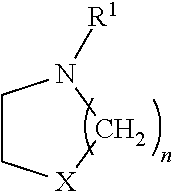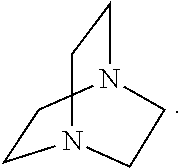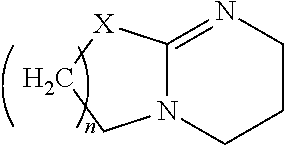Treated Fillers And Uses Thereof
a filler and filler technology, applied in the field of treated fillers, can solve the problems of unworkable, too high cure speed, and inability to finish covering ics and leds before they become viscous and unworkable,
- Summary
- Abstract
- Description
- Claims
- Application Information
AI Technical Summary
Benefits of technology
Problems solved by technology
Method used
Image
Examples
example 1
Preparation of (PhMeSiO2 / 2)0.52(PhSiO3 / 2)0.42 (45 wt % Phenyl-T)
[0169]A 500 mL 4-neck round bottom flask was loaded with Dow wt Corning 217 Flake (45.0 g, 0.329 moles Si) and toluene (Fisher Scientific, 70.38 g). The flask was equipped with a thermometer, Teflon stir paddle, and a Dean Stark apparatus attached to a water-cooled condenser. A nitrogen blanket was applied; the Dean Stark apparatus was prefilled with toluene; and an oil bath was used for heating. The reaction mixture was heated at reflux for 30 minutes. After cooling the reaction mixture to 108° C., a solution of diacetoxy terminated PhMe siloxane was added quickly. The diacetoxy terminated PhMe siloxane was prepared by adding a 50 / 50 wt % MTA / ETA (methyltriacetoxysilane / ethyltriacetoxysilane) (1.21 g, 0.00523 moles Si) mixture to a solution of 140 dp (degree of polymerization) silanol terminated PhMe siloxane (55.0 g, 0.404 moles Si) dissolved in toluene (29.62 g). The solution was mixed for 2 hours at room temperature...
example 2
[0170]A 1,8-Diazabicycloundec-7-ene (DBU) solution (0.1 wt %) was prepared by dissolving 100 mg DBU in 99.9 g toluene. Intematix RR6436 phosphor (RR6436-02A-12, 1 g; Intematix Corp., Freemont, Calif.; a Eu-doped nitride phosphor) was charged into a glass vial. Then 10 g of the 0.1 wt % DBU solution in toluene was charged to the vial. The vial was capped and put on a rotary mixer for 20 hours. Then the resulting treated phosphor was filtered out from the solution using filter paper. The wet phosphor cake is transferred to an oven and dried at 150° C. for 4 hours.
example 3
[0171]Intematix O5446 phosphor (5 g; Intematix Corp., Freemont, Calif.; a Eu-doped silicate phosphor) was charged into a glass vial. Then 10 g of 0.5 wt % DBU solution in toluene was charged to the vial. The vial was capped and put on a rotary mixer for 2 hours. Then the resulting treated phosphor was filtered out from the solution using filter paper. The wet phosphor cake was transferred to an oven and dried at 150° C. for 4 hours.
PUM
| Property | Measurement | Unit |
|---|---|---|
| Temperature | aaaaa | aaaaa |
| Time | aaaaa | aaaaa |
| Time | aaaaa | aaaaa |
Abstract
Description
Claims
Application Information
 Login to View More
Login to View More - R&D
- Intellectual Property
- Life Sciences
- Materials
- Tech Scout
- Unparalleled Data Quality
- Higher Quality Content
- 60% Fewer Hallucinations
Browse by: Latest US Patents, China's latest patents, Technical Efficacy Thesaurus, Application Domain, Technology Topic, Popular Technical Reports.
© 2025 PatSnap. All rights reserved.Legal|Privacy policy|Modern Slavery Act Transparency Statement|Sitemap|About US| Contact US: help@patsnap.com



